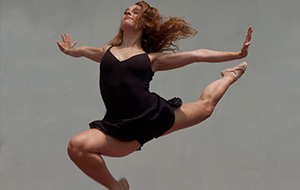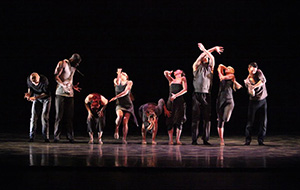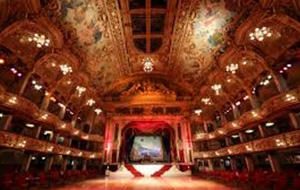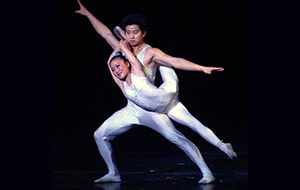 Northern Ballet has launched its second annual Choreographic Laboratory which brings together five emerging choreographers for a three-week intensive to research and develop ideas for new narrative dance, with Northern Ballet’s professional dancers. The Choreographic Laboratory culminates in Tell Tale Steps 2: Narrative in Ballet, a sharing at the Stanley & Audrey Burton Theatre in Leeds on 16 June 2016.
Northern Ballet has launched its second annual Choreographic Laboratory which brings together five emerging choreographers for a three-week intensive to research and develop ideas for new narrative dance, with Northern Ballet’s professional dancers. The Choreographic Laboratory culminates in Tell Tale Steps 2: Narrative in Ballet, a sharing at the Stanley & Audrey Burton Theatre in Leeds on 16 June 2016.
The Choreographic Laboratory began in 2015 by Northern Ballet’s Artistic Director David Nixon OBE. It is run in partnership with the Royal Ballet and curated by director and producer Jane Hackett, offering emerging choreographers the opportunity to work with Northern Ballet’s dancers to explore the creation of new narrative dance work. The scheme commits itself to nurturing choreographers and to developing talent. The experience therefore appears invaluable, with its wide ranging mentorship and tools on offer which are thought-provoking and challenging.
Carlos Pons Guerra (independent choreographer), Charlotte Edmonds (Royal Ballet Young Choreographer), Lucia Solari (First Soloist at Northern Ballet), Morgann Runacre-Temple (independent choreographer and choreographer in residence at Ballet Ireland) and Tobias Batley (Premier Dancer at Northern Ballet) have spent three weeks at Northern Ballet to explore narrative dance. The intensive also includes a programme of talks and mentorship from Sharon Watson, Artistic Director of Phoenix Dance Theatre and dance writer Luke Jennings.
The culmination of the Choreographic Laboratory is Tell Tale Steps 2: Narrative in Ballet, a sharing of the process of experimentation and research during the choreographers’ three week residency. The sharing will demonstrate their exploration of narrative dance, created characters and a sense of place and drama. The programme also includes a panel of leading arts professionals discussing the creation of narrative dance.
Month: June 2016
The Young Choreographer’s Festival
 The Young Choreographer’s Festival in New York City is celebrating its seventh year of presenting some of the most promising up-and-coming young artists. It will produce the work of 13 18-25 year olds selected by a judging panel, alongside seven Guest Artists at Symphony Space. The 2016 performance is taking place on Saturday 18 June, including the genres of contemporary, contemporary Indian, modern, jazz and street jazz.
The Young Choreographer’s Festival in New York City is celebrating its seventh year of presenting some of the most promising up-and-coming young artists. It will produce the work of 13 18-25 year olds selected by a judging panel, alongside seven Guest Artists at Symphony Space. The 2016 performance is taking place on Saturday 18 June, including the genres of contemporary, contemporary Indian, modern, jazz and street jazz.
The Young Choreographers will be joined by Guest Artists including Derek Mitchell, Jenn Freeman, Open Call’s Innovate Award Winner – Connecticut Dance Conservatory, Shelly Hutchinson Collective, SynthesisDANCE/Tracie Stanfield and White Wave/Young Soon Kim Dance Company. For the past four years, the festival has offered a discussion panel open to all young choreographers selected from 2010 onwards. 2016 is no different, and the young choreographer will have the opportunity to hear from and question members of the dance community, hosted by a YCF Advisory Board Member.
Past panelists have included Maurice Brandon Curry (artistic director of Egelvsky Ballet), Darrell Grande Moultrie (with credits from Dance Theatre of Harlem, Beyoncé and Atlanta Ballet), Camille A. Brown (leader of Camille A. Brown and Dancers), Sidra Bell (head of Sidra Bell Dance New York), Laura Diffenderfer (an associate programmer at The Joyce Theater), Ashani Mfuko (the host of Inside NYC Dance television show), Yarden Ronen (executive director of Peridance Capezio Center) and Pascal Rekoert (a Lincoln Center scholar), so this year’s artists are in for a treat.
Each Young Choreographers will be provided with a mentor also. The 2016 mentors include Michelle Barber (Broadway Dance Center faculty member), Cheryl Copeland (teacher at Millenium Dance Complex), So You Think You Can Dance choreographer Shelly Hutchinson, Calen Kurka (producer of The Showcase Series), Kat Wildish (a former dancer with American Ballet Theatre and New York City Ballet), Lane Napper (a choreographer for Nickelodeon and Disney Channel) and Matthew Shaffer (author of “So You Want to be a Dancer?”).
Audition fees cap
 Drama and dance schools across the UK may be forced to rethink their audition fees, if a recent call by Equity to do so is anything to go by. The union has stated that audition fees should be capped in order to widen access to schools and improve accessibility to training. It is a notion that has been a hot topic for many organisations and industry professionals, as for many this training is only available to those who can afford it.
Drama and dance schools across the UK may be forced to rethink their audition fees, if a recent call by Equity to do so is anything to go by. The union has stated that audition fees should be capped in order to widen access to schools and improve accessibility to training. It is a notion that has been a hot topic for many organisations and industry professionals, as for many this training is only available to those who can afford it.
A motion passed at Equity’s Annual Representative Conference claimed that the acting profession should be “more representative of the population as a whole”, and the organisation has agreed to carry out an audit of the charges requested for auditions by drama schools across the UK. These fees can be as much as £85, before travel and possible accommodation costs in order to attend the audition. The union is aiming to campaign to encourage drama schools to adhere to a UK-wide cap on audition fees.
The cap would go a long way in improving the diversity of drama schools’ intake, as well as avoiding the fact that currently, it is usually only the well-off who can afford to choose which schools they want to attend for training. For some institutions, over 3,000 audition per year; many state that the audition fee covers the administrative and operations of the audition process, as well as paying the audition panel, however some students have short contact time and little to no feedback on their audition.
For some schools, auditions last all day; some have fee waiver schemes and support some students with travel bursaries also. Others try to encourage applications from talented students from lower income backgrounds, including launching a scheme to waive the fees for target schools, welcoming the transparency this move will bring.
Gaining stage presence
 Stage presence is something that can come quite naturally to performers, however sometimes a little encouragement and pointers are required to propel a dancer in the correct direction. Whilst exceptional technique can be awe-inspiring, it is the entire package with emotion and commitment that makes a dancer unique.
Stage presence is something that can come quite naturally to performers, however sometimes a little encouragement and pointers are required to propel a dancer in the correct direction. Whilst exceptional technique can be awe-inspiring, it is the entire package with emotion and commitment that makes a dancer unique.
For a teacher, stage presence can be encouraged from an early age; as dancers grow older and progress, they may wish to compete against other dancers so must stand out. A flashy routine, however, will not always impress if there is no intention behind the movement or connection to the dance. Stage presence and a performance quality can seem elusive, but practice can aid this no end.
It is important for a dancer to commit to the story they are trying to tell, as well as connect to the music and express what they are feeling through movement. Energy, presentation and technique ultimately form a unique package, even for dancers who are inexperienced or reluctant to push themselves in a way which feels uncomfortable. Performing can be the most exciting experience and can conjure the most exhilarating emotions, and teachers can do much to nurture this.
As a teacher, encouraging students to appreciate and talk about successful performances can ensure they feel supported to express themselves. When students feel comfortable, their confidence grows and they will be more willing to try new things and push through shyness. Discussions and explorations throughout classes can help students to analyse and critique in a constructive way, in order to own and experiment with their performances, rather than choreographing empty presentation and expression.
There can be many ways to inspire students to push themselves further: by watching peers but additionally through their experiences of older and successful dancers, encouraging them to identify their performance qualities. By continually encouraging stage presence, can teachers help dancers experience a more seamless transition from practice to performance, even using classes as performance practice. Making this part of a dancers training will mean showmanship will evolve alongside technique.
Keep Dancing
 From the creators of “Spirit of the Dance”, Keep Dancing – a brand new Ballroom and Latin dance show – is set to wow audiences, featuring special guests from Strictly Come Dancing and celebrating the ever-popular world of Ballroom and Latin dance. The major tour of the UK will begin August 2016, featuring stars from Strictly including Jay McGuinness, Lisa Riley and Louis Smith. Strictly favourite Robin Windsor, and other professional dancers from Strictly Come Dancing, will dance alongside world-champion Ballroom and Latin dancers.
From the creators of “Spirit of the Dance”, Keep Dancing – a brand new Ballroom and Latin dance show – is set to wow audiences, featuring special guests from Strictly Come Dancing and celebrating the ever-popular world of Ballroom and Latin dance. The major tour of the UK will begin August 2016, featuring stars from Strictly including Jay McGuinness, Lisa Riley and Louis Smith. Strictly favourite Robin Windsor, and other professional dancers from Strictly Come Dancing, will dance alongside world-champion Ballroom and Latin dancers.
The tour will feature some of the most popular styles of Ballroom and Latin in this fast-paced, high intensity production. With dazzling costumes and breathtaking choreography, Keep Dancing includes both champion performers and stunning dance routines for non-stop entertainment.
Confirmed guest stars include singer and dancer Jay McGuinness, who be performing with his winning professional partner Aliona. Before becoming the 2015 Strictly Champion, Jay enjoyed success as a member of the band The Wanted. Louis Smith was the first British gymnast to win an Olympic medal for over 100 years at the Beijing Olympics in 2008, followed by success at the London 2012 Olympics. He was the celebrity winner of the 2012 Strictly. Lisa Riley and Robin Windsor were one of the most popular couples in the 2012 series of Strictly Come Dancing. Lisa is best known for her former long-running role in ITV’s Emmerdale, and the co-host of You’ve Been Framed.
Keep Dancing will tour to Bromley Churchill Theatre, Milton Keynes Theatre, Wimbledon New Theatre, Cardiff New Theatre, York Opera House, Manchester Palace Theatre, Woking New Theatre, Glasgow Theatre Royal, Liverpool Empire, Eastbourne Congress, Edinburgh Playhouse and Birmingham Alexandra, with 2017 tour dates to be announced soon.
Can acrobatics ever be dance?
 With gymnastics predominantly classed as a sport and dance an art, it seems the boundaries of the two are blurring as dancers aspire to more ways to stand out from the group. Of course gymnastics has always had a connection to dance – at the Olympic Games the gymnasts must incorporate an element of ‘dance’ to their floor routines – especially as dance is evolving to incorporate more content. Some may argue this is at the expense of technique and artistry.
With gymnastics predominantly classed as a sport and dance an art, it seems the boundaries of the two are blurring as dancers aspire to more ways to stand out from the group. Of course gymnastics has always had a connection to dance – at the Olympic Games the gymnasts must incorporate an element of ‘dance’ to their floor routines – especially as dance is evolving to incorporate more content. Some may argue this is at the expense of technique and artistry.
The penchée that goes past 180 degrees and the multiple ‘ice skater’ pirouettes with the foot at the ankle go some way in demonstrating the need by some dancers to impress and extend beyond the realm of dance. It goes without saying that a dancer needs a certain degree of suppleness in order to perform to a full capacity, however – especially in the competition circuit – dancers are encouraged to fill lyrical variations with oversplit legs and flips. For those adjudicating, this is not always desirable and has moved far from where dance is thought to be.
Pushing the boundaries of dance and choreography is not discouraged, in fact it is celebrated in choreographers, however the incorporation of acrobatics in dances can even be dangerous. YouTube can be a culprit, with young dancers privy to extreme dance, then inspired to overstretch and push themselves, believing this is the key to success. Injuries can occur that are not usually associated with dance, with young dancers attempting difficult gymnastic poses and extreme forms of stretching, risking immediate and long term physical harm. This is in addition to the fact it is harder to create real choreography than to insert a cartwheel!
Adding to the competition culture is the fact many young dancers see them as the ultimate goal; many competitions provide useful experience and feedback but dancing is not just about winning. As an extension, the gymnastic and acrobatic moves practised have little to do with the professional dance world – very few companies in today’s ballet or contemporary dance companies would require this. Companies would be more interested if the dancer can blend into their existing group and not miss basic elements that are foundations in the professional dance industry.
